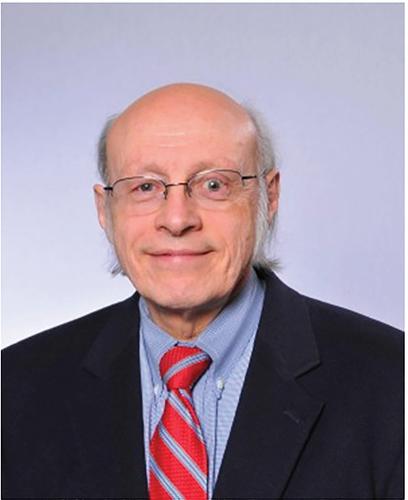当前位置:
X-MOL 学术
›
J. Raman Spectrosc.
›
论文详情
Our official English website, www.x-mol.net, welcomes your
feedback! (Note: you will need to create a separate account there.)
SERS and the scientific career of Richard P. Van Duyne (1945–2019)
Journal of Raman Spectroscopy ( IF 2.4 ) Pub Date : 2020-12-04 , DOI: 10.1002/jrs.6052 George C. Schatz 1
Journal of Raman Spectroscopy ( IF 2.4 ) Pub Date : 2020-12-04 , DOI: 10.1002/jrs.6052 George C. Schatz 1
Affiliation

|
This article describes the scientific career of our dear friend Richard P. Van Duyne. Rick was the discoverer of surface‐enhanced Raman spectroscopy (SERS), and over the period from the mid‐1970s until his death in 2019, he served as both the intellectual leader of the field, and the technical genius who pushed the field forward through his numerous inventions and discoveries. Rick's work went through many phases, and even involved a significant period of inactivity that Rick was able to break out of, but especially after 2000, there was a period of incredible creativity that ultimately led to a detailed understanding of what the SERS enhancement factor is all about and also led to fabrication techniques for making optimum SERS substrates such that applications of SERS to a wide variety of real‐world problems in sensing became possible. In addition, Rick's SERS work spawned numerous related technologies, including index of refraction sensing based on localized surface plasmon resonance (LSPR) measurements, and the extension of SERS to its tip‐enhanced cousin TERS, to electrochemical versions of SERS and TERS, and to ultrafast nonlinear techniques. The practical applications he pursued included diagnostics for diseases such as cancer, hand‐held glucose sensing, and SERS studies related to art conservation. However, Rick's legacy will probably be best known through the numerous students, postdocs, and collaborators that passed through his lab and who are now active researchers in areas related to SERS at universities and industrial labs around the world.
中文翻译:

SERS和Richard P. Van Duyne的科学生涯(1945–2019)
本文介绍了我们亲爱的朋友Richard P. Van Duyne的科学生涯。里克(Rick)是表面增强拉曼光谱(SERS)的发现者,从1970年代中期到2019年去世,他既是该领域的知识带头人,又是推动该领域前进的技术天才他的众多发明和发现。Rick的工作经历了多个阶段,甚至经历了一段很长的闲置时间,Rick得以突破,但是尤其是在2000年之后,有一段令人难以置信的创造力,最终导致人们对SERS增强因素是什么有了更深入的了解。所有这些都导致了制造最佳SERS基板的制造技术,从而使SERS应用于各种现实世界中的传感问题成为可能。此外,Rick的SERS研究产生了许多相关技术,包括基于局部表面等离振子共振(LSPR)测量的折射率传感,以及将SERS扩展到其尖端增强的表亲TERS,电化学版本的SERS和TERS以及超快非线性技术。他从事的实际应用包括对癌症等疾病的诊断,手持式葡萄糖感应和与艺术保护有关的SERS研究。但是,Rick的遗产可能会通过他的实验室中的众多学生,博士后和合作者而广为人知,他们现在是全球大学和工业实验室中与SERS相关领域的活跃研究人员。包括基于局部表面等离振子共振(LSPR)测量的折射率感应,SERS扩展到其尖端增强的表亲TERS,SERS和TERS的电化学形式以及超快非线性技术。他从事的实际应用包括对癌症等疾病的诊断,手持式葡萄糖感应和与艺术保护有关的SERS研究。但是,Rick的遗产可能会通过他的实验室中的众多学生,博士后和合作者而广为人知,他们现在是全球大学和工业实验室中与SERS相关领域的活跃研究人员。包括基于局部表面等离振子共振(LSPR)测量的折射率感应,SERS扩展到其尖端增强的表亲TERS,SERS和TERS的电化学形式以及超快非线性技术。他从事的实际应用包括对癌症等疾病的诊断,手持式葡萄糖感应以及与艺术保护有关的SERS研究。但是,Rick的遗产可能会通过他的实验室中的众多学生,博士后和合作者而广为人知,他们现在是全球大学和工业实验室中与SERS相关领域的活跃研究人员。他从事的实际应用包括对癌症等疾病的诊断,手持式葡萄糖感应以及与艺术保护有关的SERS研究。但是,Rick的遗产可能会通过他的实验室中的众多学生,博士后和合作者而广为人知,他们现在是全球大学和工业实验室中与SERS相关领域的活跃研究人员。他从事的实际应用包括对癌症等疾病的诊断,手持式葡萄糖感应和与艺术保护有关的SERS研究。但是,Rick的遗产可能会通过他的实验室中的众多学生,博士后和合作者而广为人知,他们现在是全球大学和工业实验室中与SERS相关领域的活跃研究人员。
更新日期:2020-12-04
中文翻译:

SERS和Richard P. Van Duyne的科学生涯(1945–2019)
本文介绍了我们亲爱的朋友Richard P. Van Duyne的科学生涯。里克(Rick)是表面增强拉曼光谱(SERS)的发现者,从1970年代中期到2019年去世,他既是该领域的知识带头人,又是推动该领域前进的技术天才他的众多发明和发现。Rick的工作经历了多个阶段,甚至经历了一段很长的闲置时间,Rick得以突破,但是尤其是在2000年之后,有一段令人难以置信的创造力,最终导致人们对SERS增强因素是什么有了更深入的了解。所有这些都导致了制造最佳SERS基板的制造技术,从而使SERS应用于各种现实世界中的传感问题成为可能。此外,Rick的SERS研究产生了许多相关技术,包括基于局部表面等离振子共振(LSPR)测量的折射率传感,以及将SERS扩展到其尖端增强的表亲TERS,电化学版本的SERS和TERS以及超快非线性技术。他从事的实际应用包括对癌症等疾病的诊断,手持式葡萄糖感应和与艺术保护有关的SERS研究。但是,Rick的遗产可能会通过他的实验室中的众多学生,博士后和合作者而广为人知,他们现在是全球大学和工业实验室中与SERS相关领域的活跃研究人员。包括基于局部表面等离振子共振(LSPR)测量的折射率感应,SERS扩展到其尖端增强的表亲TERS,SERS和TERS的电化学形式以及超快非线性技术。他从事的实际应用包括对癌症等疾病的诊断,手持式葡萄糖感应和与艺术保护有关的SERS研究。但是,Rick的遗产可能会通过他的实验室中的众多学生,博士后和合作者而广为人知,他们现在是全球大学和工业实验室中与SERS相关领域的活跃研究人员。包括基于局部表面等离振子共振(LSPR)测量的折射率感应,SERS扩展到其尖端增强的表亲TERS,SERS和TERS的电化学形式以及超快非线性技术。他从事的实际应用包括对癌症等疾病的诊断,手持式葡萄糖感应以及与艺术保护有关的SERS研究。但是,Rick的遗产可能会通过他的实验室中的众多学生,博士后和合作者而广为人知,他们现在是全球大学和工业实验室中与SERS相关领域的活跃研究人员。他从事的实际应用包括对癌症等疾病的诊断,手持式葡萄糖感应以及与艺术保护有关的SERS研究。但是,Rick的遗产可能会通过他的实验室中的众多学生,博士后和合作者而广为人知,他们现在是全球大学和工业实验室中与SERS相关领域的活跃研究人员。他从事的实际应用包括对癌症等疾病的诊断,手持式葡萄糖感应和与艺术保护有关的SERS研究。但是,Rick的遗产可能会通过他的实验室中的众多学生,博士后和合作者而广为人知,他们现在是全球大学和工业实验室中与SERS相关领域的活跃研究人员。











































 京公网安备 11010802027423号
京公网安备 11010802027423号